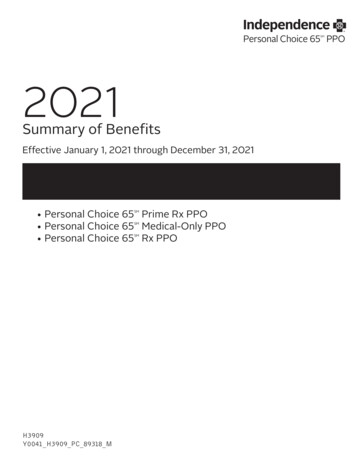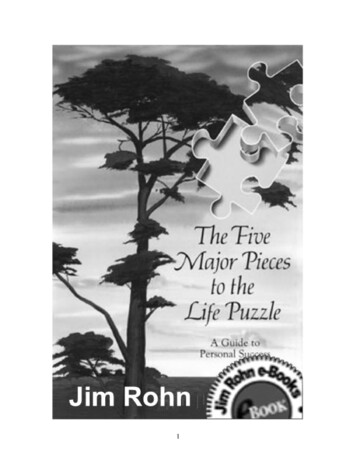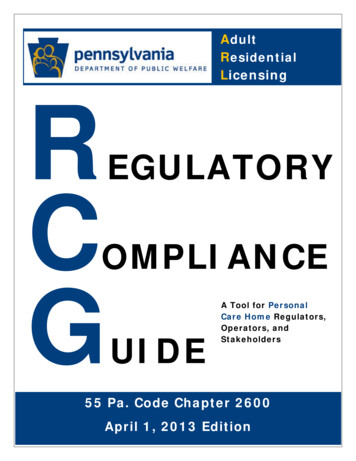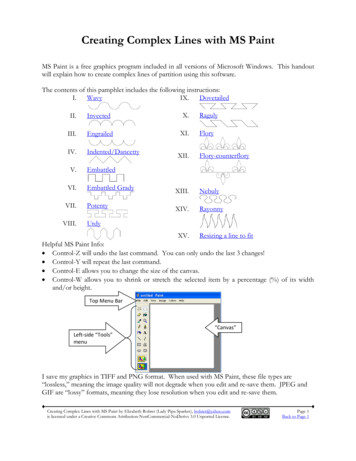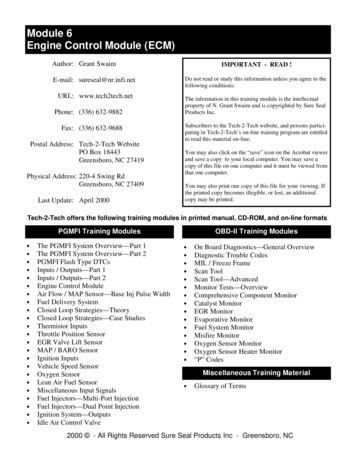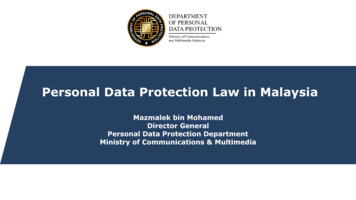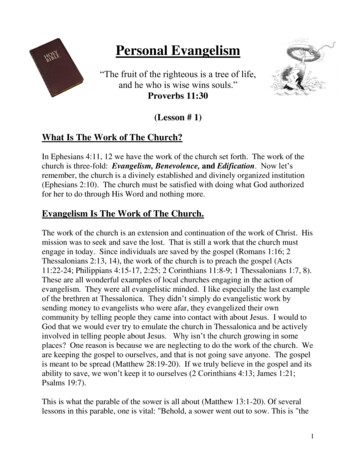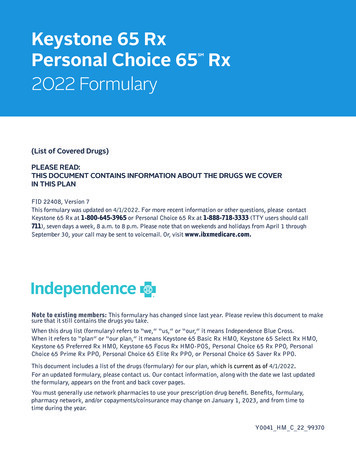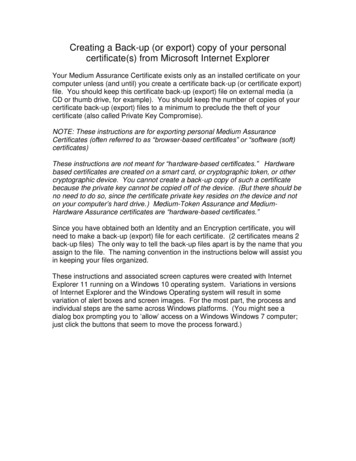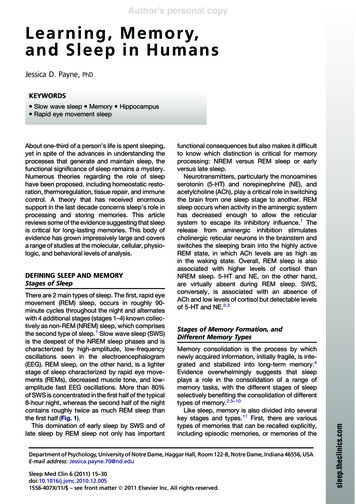
Transcription
Author's personal copyL e a r n i n g , M e m o r y,and S le ep i n HumansJessica D. Payne, PhDKEYWORDS! Slow wave sleep ! Memory ! Hippocampus! Rapid eye movement sleepDEFINING SLEEP AND MEMORYStages of SleepThere are 2 main types of sleep. The first, rapid eyemovement (REM) sleep, occurs in roughly 90minute cycles throughout the night and alternateswith 4 additional stages (stages 1–4) known collectively as non-REM (NREM) sleep, which comprisesthe second type of sleep.1 Slow wave sleep (SWS)is the deepest of the NREM sleep phases and ischaracterized by high-amplitude, low-frequencyoscillations seen in the electroencephalogram(EEG). REM sleep, on the other hand, is a lighterstage of sleep characterized by rapid eye movements (REMs), decreased muscle tone, and lowamplitude fast EEG oscillations. More than 80%of SWS is concentrated in the first half of the typical8-hour night, whereas the second half of the nightcontains roughly twice as much REM sleep thanthe first half (Fig. 1).This domination of early sleep by SWS and oflate sleep by REM sleep not only has importantfunctional consequences but also makes it difficultto know which distinction is critical for memoryprocessing: NREM versus REM sleep or earlyversus late sleep.Neurotransmitters, particularly the monoaminesserotonin (5-HT) and norepinephrine (NE), andacetylcholine (ACh), play a critical role in switchingthe brain from one sleep stage to another. REMsleep occurs when activity in the aminergic systemhas decreased enough to allow the reticularsystem to escape its inhibitory influence.1 Therelease from aminergic inhibition stimulatescholinergic reticular neurons in the brainstem andswitches the sleeping brain into the highly activeREM state, in which ACh levels are as high asin the waking state. Overall, REM sleep is alsoassociated with higher levels of cortisol thanNREM sleep. 5-HT and NE, on the other hand,are virtually absent during REM sleep. SWS,conversely, is associated with an absence ofACh and low levels of cortisol but detectable levelsof 5-HT and NE.2,3Stages of Memory Formation, andDifferent Memory TypesMemory consolidation is the process by whichnewly acquired information, initially fragile, is integrated and stabilized into long-term memory.4Evidence overwhelmingly suggests that sleepplays a role in the consolidation of a range ofmemory tasks, with the different stages of sleepselectively benefiting the consolidation of differenttypes of memory.2,5–10Like sleep, memory is also divided into severalkey stages and types.11 First, there are varioustypes of memories that can be recalled explicitly,including episodic memories, or memories of theDepartment of Psychology, University of Notre Dame, Haggar Hall, Room 122-B, Notre Dame, Indiana 46556, USAE-mail address: Jessica.payne.70@nd.eduSleep Med Clin 6 (2011) 15–30doi:10.1016/j.jsmc.2010.12.0051556-407X/11/ – see front matter ! 2011 Elsevier Inc. All rights reserved.sleep.theclinics.comAbout one-third of a person’s life is spent sleeping,yet in spite of the advances in understanding theprocesses that generate and maintain sleep, thefunctional significance of sleep remains a mystery.Numerous theories regarding the role of sleephave been proposed, including homeostatic restoration, thermoregulation, tissue repair, and immunecontrol. A theory that has received enormoussupport in the last decade concerns sleep’s role inprocessing and storing memories. This articlereviews some of the evidence suggesting that sleepis critical for long-lasting memories. This body ofevidence has grown impressively large and coversa range of studies at the molecular, cellular, physiologic, and behavioral levels of analysis.
Author's personal copy16PayneFig. 1. A sleep histogram showing the typical distribution of SWS and REM sleep.events in our lives. Retrieving an episodic memoryfrom one’s past requires access to definingcontextual features of the event, such as specificdetails about the place and time of its occurrence.Because of this emphasis on spatial context,episodic memories and spatial memories areclosely connected. Second, there are semanticmemories, which are concerned with the knowledge one acquires during events but is itself separated from the specific event in question. Thus, ourknowledge about the meaning of words and factsabout the world, even though acquired in thecontext of some specific experience, appears tobe stored in a context-independent format (eg,not bound to the originating context). Third, thereare “how to” memories for the various skills,procedures, and habits that we acquire throughexperience. Because these memories are not soeasily made explicit and are usually only evidentin behavior, they are referred to as procedural orimplicit memories. Finally, there are emotionalmemories for the positive and negative experiences in our lives. This class of memories is especially concerned with learning about fearful andnegative stimuli, although evidence suggests itplays a role in learning about pleasant informationas well.12Evidence suggests that each of these memorytypes is subserved by distinct neural systems.11–13Whereas episodic and spatial memories are governed by the hippocampus and surroundingmedial temporal areas, procedural or implicitmemories are thought to be independent of thehippocampus and anatomically related regions,relying instead on various neocortical and subcortical structures. The emotional memory system iscentered in the amygdala, a limbic structure thatis richly connected to the hippocampus.14 Importantly, evidence suggests that information dependent on each of these systems is processeddifferently during sleep. Although somewhatoversimplified,15 there is a general consensusthat NREM sleep, especially SWS, is importantfor the consolidation of explicit episodic andspatial memories, both of which rely on the hippocampus for their consolidation,16 whereas REMsleep selectively benefits procedural andemotional memories.17,18In addition to these distinct types, memoryconsolidation also consists of different stages.Although our experience of memory occurs atthe moment of retrieval when information aboutthe initial experience returns to conscious awareness, successful retrieval is contingent on thesuccessful completion of at least 2 earlier stagesof memory formation. First, the experience orinformation must be properly encoded. Encodinginvolves transforming new information into a representation capable of being stored in memory, justas the key presses that are made on a keyboardmust be converted to a format that can be storedin a computer. Second, the information must beconsolidated or durably stored in a manner thatcan withstand the passage of time. Only if theseprocesses occur successfully will it be possiblefor information from the initial event to be retrievedlater in time. Although this article mostly focuseson memory consolidation, it also briefly reviewsnew evidence that sleep is essential for effectivememory encoding.SLEEP BENEFITS IMPLICIT AND PROCEDURALMEMORIESSleep seems to benefit the consolidation of bothimplicit and explicit forms of memory. Convergingdata suggest that most procedural skills and abilities (eg, performing a surgery, riding a bike) areacquired slowly and are not attained solely duringthe learning episode. While some learning certainly
Author's personal copySleep and Memorydevelops quickly, performance on various procedural tasks improves further and without additionalpractice simply through the passage of time,particularly if these periods contain sleep. Theseslow off-line improvements occur as newlyacquired information, initially fragile, is integratedand stabilized into long-term memory.Early work investigating the effect of sleep onimplicit learning used a visual texture discriminationtask (VDT) originally developed by Karni and Sagi.19The task requires participants to determine theorientation (vertical or horizontal) of an array of diagonal bars that is embedded in one visual quadrantagainst a background of exclusively horizontalbars (Fig. 2). At the center of the screen is the fixation target, which is either the letter T or the letterL. This target screen is succeeded first by a blankscreen for a variable interstimulus interval (ISI) andthen by a mask (a screen covered with randomlyoriented V’s with a superimposed T and L in thecenter). Subjects must determine the orientation ofthe array, and the performance is estimated by theISI corresponding to 80% correct responses.19,20Amnesic patients with damage to the hippocampal complex, who cannot acquire knowledgeexplicitly, show normal performance improvements on the VDT.21 In neurologically normalsubjects, improvement on the VDT developsslowly after training,19,22 with no improvementwhen retesting occurs on the same day as training(Fig. 3A). Instead, improvement is only observedafter a night of sleep (see Fig. 3A). This observation was true even for a group of subjects whowere retested only 9 hours after training. Importantly, there was not even a trend to greaterimprovement when the training-retest intervalwas increased from 9.0 to 22.5 hours, suggestingthat additional wake time after the night of sleepprovided no additional benefit. Whereas furtherwake time provided no benefit, additional nightsof sleep did produce incremental improvement.When subjects were retested 2 to 7 days aftertraining rather than after a single night of sleepFig. 2. (A–C) Sample screens from the VDT.a 50% greater improvement was observed (seeFig. 3B). Critically, another group of subjects wassleep deprived on the first night after training.These subjects were allowed 2 full nights ofrecovery sleep before being retested 3 days later.The subjects failed to show any residual learning,suggesting that performance enhancementsdepend on a normal first night of sleep (seeFig. 3B). Time alone is clearly not enough toproduce long-term benefits from VDT training. Itseems that sleep is also required.22Initially, improvement on this task seemed todepend solely on REM sleep, because subjectswho underwent selective deprivation of REM sleepshowed no improvement on the task.20 Laterstudies, however, showed that optimal performance on this task requires both SWS and REMsleep.23When subjects were trained and their subsequent sleep monitored in the sleep laboratory,the amount of improvement was proportional tothe amount of SWS during the first quarter of thenight (Fig. 4A), as well as to the amount of REMsleep in the last quarter (see Fig. 4B). Indeed, theproduct of these 2 sleep parameters explainedmore than 80% of the intersubject variance (seeFig. 4D). No significant correlations were foundfor sleep stage during other parts of the night(see Fig. 4C) or for the amount of stage 2 sleepat any time during the night.Gais and colleagues24 came to a similar conclusion by examining improvement after 3 hours ofsleep either early or late in the night. They foundthat 3 hours of early night sleep, which was richin SWS, produced an 8-millisecond improvement,but after a full night of sleep, which added REMrich sleep late in the night, a 26-millisecondimprovement was observed, 3 times that seenwith early sleep alone. However, 3 hours of REMrich, late night sleep actually produced deterioration in performance.24 These results are furthercorroborated by daytime nap studies. Afternoonnaps as short as 60 to 90 minutes also lead to17
Author's personal copyPayneB20DaytimeOvernight*1006**1218Improvement (ms)Improvement (ms)A243025201510500123DaysTest interval (h)47Fig. 3. Sleep-dependent improvement on the VDT. All subjects were trained and then retested only once. Eachpoint in (A) and each green bar in (B) represents a separate group of subjects. Error bars in (A) and (B) areSEM. (A) There was no improvement when retesting occurred on the same day as training (open circles), but therewas improvement after a night of sleep (closed circles). Asterisks indicate significant effects. (B) (Green bars)Improvement in performance of subjects when retested 2 to 7 days of training. (Red bar) No improvement inperformance of subjects who were sleep deprived on the first night of training. ms, milliseconds. (From StickgoldR, James L, Hobson JA. Visual discrimination learning requires post-training sleep. Nat Neurosci 2000;2(12):1237–8; with permission; and Stickgold R, Whidbee D, Schirmer B, et al. Visual discrimination task improvement: a multi-step process occurring during sleep. J Cognit Neurosci 2000;12:246–54; with permission.)performance benefits on the VDT, especially whenthey contain REM and NREM sleep.25,26At this point, sleep’s role in visual discriminationlearning (as measured by VDT performance) isclear. But the VDT represents a very specificAtype of sensory memory that may or may not shareits sleep dependency with other procedural tasks.This specificity raises the question of whether thesleep effects observed with the VDT generalizeto other forms of procedural memory. Studies ofB40r 0.70P .01230201001552030201001st quartile SWS (% of night)0.8DP .010.6P .050.40.20.012QuartileSWS351510204th quartile REM (% of night)4REMImprovement (ms)Cr 0.76P .004Improvement (ms)Improvement (ms)40Pearson r value1840r 0.89P .0001302010050100150200SWS 1 x REM 4 (% x %)Fig. 4. (A–D) REM sleep and SWS dependence of VDT learning. ms, milliseconds; REM4, 4th quartile of REM sleep;SWS1, 1st quartile of SWS. (From Stickgold R, Whidbee D, Schirmer B, et al. Visual discrimination task improvement: a multi-step process occurring during sleep. J Cognit Neurosci 2000;12:246–54; with permission.)
Author's personal copySleep and Memorysleep-dependent motor skill learning stronglysuggest that they do.As an example, Walker and colleagues27 havedemonstrated sleep-dependent improvements ona finger tapping task. The task requires subjectsto repeatedly type the numeric sequence 4-1-32-4 as quickly and accurately as possible with thenon-dominant hand. Training consisted of twelve30-second trials separated by 30-second restperiods. All subjects show considerable improvement during the 12 trials of the training session (afast learning component), but 12 hours later, thesubjects performed differently depending onwhether the 12-hour interval was spent sleepingor awake. When trained in the morning andretested 12 hours later, only an additional nonsignificant 4% improvement was seen in performance, but when tested again the next morning,a large and robust (14%) improvement was seen(Fig. 5A). The failure to improve during the daytimecould not be caused by interference from relatedmotor activity because subjects who were requiredto wear mittens and refrain from fine motor activities during this time showed a similar pattern ofwake/sleep improvement (see Fig. 5B).In contrast, when subjects were trained in theevening, improvement was observed the followingmorning (after sleep) but not across an additional12 hours of wake (see Fig. 5C). Thus, improvedperformance resulted specifically from a night ofsleep as opposed to the simple passage of time.Curiously, unlike the findings for the VDT, overnightimprovement on this task correlated with theamount of stage 2 NREM sleep during the night,especially during the last quarter of the night.These findings are in agreement with those ofFogel and colleagues,28 Smith and MacNeill,29and Tweed and colleagues,30 who have alsoshown that stage 2 sleep and possibly the sleepspindles that reach peak density during late nightstage 2 sleep are critical for simple motor memoryconsolidation. This role of sleep spindles seemsplausible because they have been proposed totrigger intracellular mechanisms that are requiredfor synaptic plasticity.31This motor sequence task has been examined todetermine where precisely in the motor programthis sleep-dependent improvement occurs.32 Inthe sequence mentioned earlier (4-1-3-2-4), thereare 4 unique key-press transitions: 4 to 1, 1 to 3,3 to 2, and 2 to 4. When the speed between transitions was analyzed for individual subjects beforesleep, “sticking points” emerged. Whereas sometransitions were easy (ie, fast), others were problematic (ie, slow), as if the sequence was beingparsed or chunked into smaller bits duringpresleep learning.21 After a night of sleep, theseproblematic points were preferentially improved,whereas transitions that had already beenmastered before sleep did not change. Subjectswho were trained and retested after a daytimewake interval showed no such improvements.These findings suggest that the sleepdependent consolidation process involves theFig. 5. (A–C) Sleep-dependent motor learning. Improvement in speed was seen in all 3 groups over a night ofsleep but not over 12 hours of daytime wake. (From Walker M, Brakefield T, Morgan A, et al. Practice with sleepmakes perfect: sleep dependent motor skill learning. Neuron 2002;35:205–11; with permission.)19
Author's personal copy20Payneunification of smaller motor memory units intoa single motor memory representation, therebyimproving problem points in the sequence. Importantly, this finding suggests that the role of sleep issubtle and complex and that sleep does morethan simply strengthen memories; sleep mayencourage the restructuring and reorganization ofmemories, an important and often-overlookedaspect of memory consolidation. The author returns to this idea later in the article.Moving to another type of motor memory, motoradaptation, Maquet and colleagues33 showed thatsleep benefits performance on a motor pursuittask. Participants were trained to use a joystickto keep the cursor on a target when the targettrajectory was predictable only on the horizontalaxis, which meant that optimal performance couldonly be achieved by developing an implicit modelof the motion characteristics of the learned trajectory. Half of the subjects were sleep deprived onthe first posttraining night, whereas the other halfwere allowed to sleep normally. Three days later,after 2 full nights of recovery sleep, performancewas superior in the sleep group compared withthe sleep-deprived group, and functional magneticresonance imaging (fMRI) revealed that that thesuperior temporal sulcus (STS) was differentiallymore active for the learned trajectory in subjectswho slept than in the sleep-deprived subjects.Moreover, increased functional connectivity wasobserved between the STS and the cerebellumand between the supplementary and frontal eyefields, suggestive of sleep-related plastic changesduring motor skill consolidation in areas involved insmooth pursuit and eye movements.Admittedly, visual discrimination, finger tapping,and motor adaptation are all relatively basic lowlevel procedural tasks that may become automated fairly quickly. What about the morecomplex implicit and procedural tasks? Work onanimals clearly demonstrates that complex tasks(eg, instrumental conditioning, avoidance, ormaze learning) benefit from sleep, with ratsshowing increases in REM sleep that continue untilthe tasks are mastered.34–36REM sleep has been implicated in complexprocedural learning in humans as well. In a positronemission tomographic study of visuomotor skillmemory using the serial reaction time task,37 6spatially permanent position markers were shownon a computer screen and subjects watched forstimuli to appear below these markers. Whena stimulus appeared in a particular position,subjects reacted as quickly as possible bypressing a corresponding key on the keyboard.Because the stimuli were generated in an orderdefined by a probabilistic finite-state grammar,improvement on the task (compared withrandomly generated sequences) reflects implicitlyacquired knowledge of this grammar.37Neuroimaging was performed on 3 groups ofsubjects. One group was scanned while theywere awake, both at rest and during performanceof the task, providing information about whichbrain regions are typically activated by the task.A second group of subjects was trained on thetask during the afternoon and then scanned thenight after training, both while awake and duringvarious sleep stages. Thus, group 2 was includedto determine if similar brain regions were reactivated during sleep. A postsleep session was alsoconducted to verify that learning had indeedoccurred. Finally, a third group, never trained onthe task, was scanned while sleeping to ensurethat the pattern of activation present in naturalsleep was different from the pattern of activationpresent after training.Results showed that during REM sleep, ascompared with resting wakefulness, several brainareas used during task performance were moreactive in trained than in nontrained subjects. Theseareas included occipital, parietal, anterior cingulate, motor, and premotor cortices and the cerebellum, all activations that are consistent with thecomponent processes involved in the visual andmotor functioning involved in this task. Behavioraldata confirmed that trained subjects improvedsignificantly more across the night.Peigneux and colleagues,38 using the same task,showed that the level of acquisition of probabilisticrules attained before sleep was correlated with theincrease in activation of task-related cortical areasduring posttraining REM sleep. This observationsuggests that cerebral reactivation is modulatedby the strength of the memory traces developedduring the learning episode, and as such, thesedata provide the first experimental evidence linkingbehavioral performance to reactivation duringREM sleep.38 Together with animal studies,39,40these findings suggest that it is not simply experiencing the task, but the process of memoryconsolidation associated with successful learningof the task that modifies sleep physiology.These results support the idea that implicit/procedural memory traces in humans can be reactivated during REM sleep, and that this reactivation is linked to improved consolidation. Indeed,looking a bit more closely at the literature, humanREM sleep has also been linked to memory forcomplex logic games, to foreign language acquisition, and to intensive studying.41 It is interestingthat these more-complex conceptual-proceduraltasks often show REM sleep relationships,whereas more basic procedural tasks benefit
Author's personal copySleep and Memorymainly from NREM sleep. The above-mentionedfindings provide encouraging evidence thatsleep-based processes can aid in proceduralmemory consolidation, not only for basic formsof sensory and motor memory in humans butalso for complex procedural and conceptualknowledge. Moreover, these findings indicatethat the consolidation of familiar skills, or thosethat are similar to other well-learned skills, maybe reliant on NREM sleep stages (particularlystage 2 NREM sleep), whereas REM sleep maybe required for the integration of new conceptsor skills with preexisting information stored inmemory.42 This is an important concept thatwarrants future investigation.Clearly, sleep is crucial to the consolidation ofprocedural memory. Although both the stabilizationof explicitly learned motor skills and off-lineimprovements in pure implicit tasks may evolveover time spent awake,43,44 the posttrainingenhancement of motor skills seems to be exclusively dependent on sleep.27 Participants withinsomnia show impaired sleep-related proceduralmemory consolidation compared with participantswith undisturbed sleep,45 and schizophrenia, whichis associated with changes in sleep, particularly instage 2 NREM sleep spindles,46,47 is also associated with procedural memory deficits.48 Morerecently, Dresler and colleagues49 demonstratedthat off-line procedural memory consolidation isalso disturbed in depression, another conditionassociated with changes in sleep architecture.SLEEP BENEFITS EXPLICIT MEMORIESThis section describes the relationship betweensleep and the consolidation of explicit memories.There is a general consensus that NREM sleep,especially SWS, is important for the consolidationof hippocampus-dependent episodic and spatialmemories.16 In a landmark study, Plihal andBorn50 assessed the recall of word pairs (anepisodic memory task) and improvement in mirrortracing (a procedural memory task) after retentionintervals of early sleep (the first 3–4 hours of thesleep cycle), which, as noted in the previoussections, is dominated by SWS, and late sleep(the last 3–4 hours of the sleep cycle), which isdominated by REM sleep. Recall of word pairsimproved more significantly after a 3-hour sleepperiod rich in SWS than after a 3-hour sleep periodrich in REM sleep or a 3-hour period of wakefulness. Mirror tracing, on the other hand, improvedsignificantly more after a 3-hour sleep period richin REM sleep than after 3 hours spent either inSWS or awake.Similarly, using a nap paradigm, Tucker andcolleagues51 found that naps containing onlyNREM sleep enhanced memory for word pairsbut did not benefit mirror tracing. After an afternoon training session, performance on these taskswas assessed after a 6-hour delay, either with orwithout an intervening nap. The subjects whowere allowed a nap not only recalled more wordpairs than the subjects who remained awake(Fig. 6) but also showed a weak correlationbetween improved recall and the amount of SWSin the nap.These results are consistent with neurophysiological evidence derived from electrophysiologicalstudies in rodents, which demonstrate thatpatterns of hippocampal place cell activity firstseen during waking exploration are later reexpressed during postlearning SWS.52–54 Similarly,Fig. 6. (A, B) A brief daytime nap benefits episodic memory. Note that the nap (which did not contain REM sleep)benefited episodic, but not procedural memory. Asterisks indicate significant differences between groups. (FromTucker MA, Hirota Y, Wamsley EJ, et al. A daytime nap containing solely non-REM sleep enhances declarative butnot procedural memory. Neurobiol Learn Mem 2006;86(2):241–7; with permission.)21
Author's personal copy22Payneseveral neuroimaging studies in humans have suggested an important role for SWS in hippocampusdependent memory consolidation. The first ofthese studies investigated performance on a hippocampally-dependent virtual maze task.55 Daytimelearning of the task was associated with hippocampal activity. During posttraining sleep, therewas a reemergence of hippocampal activation,and this activation occurred specifically duringSWS. The most compelling finding, however, isthat the increase in hippocampal activation seenduring posttraining SWS was proportional to theamount of improvement seen the next day. Thisfinding suggests that the reexpression of hippocampal activation during SWS reflects the off-linereprocessing of spatial episodic memory traces,which in turn leads to the plastic changes underlying the improvement in memory performanceseen the next day. Similarly, Rasch andcolleagues56 exposed human subjects to an odorwhile they were learning object-location pairingsin a task similar to the memory game “concentration;” subjects who were reexposed to the odorduring SWS (but not REM sleep) showed enhancedhippocampal activity and enhanced memory forthe memory pairings.Another study57 investigated the time course ofepisodic memory consolidation across 90 days.Subjects studied 360 photographs of landscapesand were then tested on subsets of the photographs either after a nap the same day or after 2,30, or 90 days. Before each test, subjects studied80 new pictures and then were tested on 80 of theoriginal pictures and the 80 new ones as well as80 pictures that they had never seen before. Allmemory retrieval sessions occurred during fMRIscanning. After the initial 90-minute nap, stage 2sleep was positively correlated with successfulrecall of both remote and recent items, indicatinga nonspecific benefit of stage 2 NREM sleep onepisodic memory. This is an intriguing finding, giventhat stage 2 is when sleep spindles are most prominent (see section on neurophysiological andneurochemical evidence for sleep’s role in memoryconsolidation later). SWS, on the other hand, wascorrelated only with memory for remote (but notrecent) items. Because performance on remoteitems increased with longer SWS duration, butperformance for recent items did not, the effecton memory performance for remote items cannotbe explained by a general effect of SWS on memoryretrieval processes. These findings stronglysuggest that episodic memories can undergo initialconsolidation within a rather short time frame andthat this consolidation is promoted by SWS.These observations suggest that learning triggers the reactivation of episodic memory tracesduring NREM SWS, a process that in turnenhances behavioral performance.SLEEP BENEFITS EMOTIONAL MEMORYCONSOLIDATIONSleep also contributes to the consolidation ofemotional episodic memories. As noted in theprevious section, sleep clearly benefits memoryfor neutral episodic memory materials acrossboth verbal and spatial modalities.5,16 However,when emotional (especially emotionally negative)episodic items are intermixed with neutral itemsin a study, sleep disproportionately benefits theconsolidation of emotional memories relative toneutral memories. For example, Hu andcolleagues58 examined the effect of a full night’ssleep on both axes of emotional affect, valence(positive/negative) and arousal (high/low), acrossboth “remember” and “know” judgments ofmemory for pictures. Results showed that a nightof sleep improved memory accuracy for emotionally arousing pictures relative to an equivalentperiod of daytime wakefulness, but only for knowjudgments. No differences were observed forremember judgments. Moreover, memory biaschanged across a night of sleep relative to wake,such that subjects became more conservativewhen making remember judgments, especiallyfor emotionally arousing pictures. No bias differences were observed for know judgmentsbetween sleep and wake.REM sleep may be particularly important forthe consolidation of emotional memories, whichrely critically on the amygdala for theirconsolidation.7,59 Wag
the second type of sleep.1 Slow wave sleep (SWS) is the deepest of the NREM sleep phases and is characterized by high-amplitude, low-frequency oscillations seen in the electroencephalogram (EEG). REM sleep, on the other hand, is a lighter stage of sleep characterized by rap

